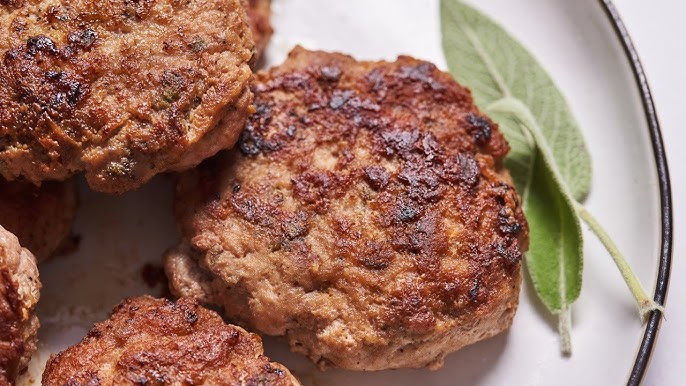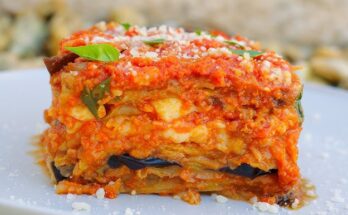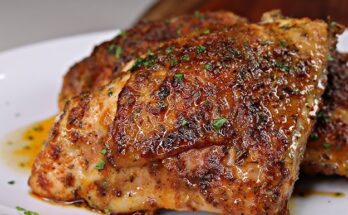Turkey Sausage Recipe: Turkey sausage is a lean, flavorful alternative to traditional pork or beef sausages. It’s made primarily from ground turkey meat combined with herbs, spices, and sometimes a bit of fat or filler to enhance flavor and texture. With its rising popularity among health-conscious individuals, turkey sausage offers a lower-calorie, lower-fat option while still delivering a satisfying taste.
Whether you’re looking to cut down on red meat or simply want a change in your breakfast lineup, turkey sausage is a versatile choice that fits into almost any meal plan. It’s especially great for people trying to manage cholesterol, saturated fat, or calorie intake without sacrificing flavor.
Turkey sausage can be made into patties, links, or crumbles. Homemade versions are even better because you control the seasoning and ingredients, steering clear of preservatives or artificial additives. Making it at home is surprisingly easy and allows for customization that suits any taste preference.
Why Choose Turkey Over Pork or Beef?
There are several reasons people switch to turkey sausage:
- Health Benefits: Turkey is significantly lower in saturated fat compared to pork and beef. This makes it heart-healthier and better for cholesterol levels.
- Calories: Turkey sausage typically contains fewer calories, which makes it a good option for weight management.
- Digestibility: For some people, turkey is easier on the stomach and less greasy, making it more suitable for sensitive digestive systems.
- Flavor Control: Ground turkey has a mild flavor, so it pairs well with a wide range of spices and herbs, letting you control the taste entirely.
Ingredients You’ll Need
Ground Turkey and Seasonings
Here’s a list of basic ingredients you’ll need to whip up a delicious turkey sausage at home:
- 1 lb ground turkey (93% lean recommended)
- 1 tsp salt
- 1/2 tsp black pepper
- 1/2 tsp smoked paprika
- 1/2 tsp garlic powder
- 1/2 tsp onion powder
- 1 tsp ground sage
- 1/2 tsp thyme
- 1/4 tsp crushed red pepper flakes (optional for spice)
- 1 tbsp olive oil or melted butter (for added moisture)
These spices form the backbone of the sausage flavor profile, bringing out a savory and slightly smoky taste that mimics traditional sausage while staying light and healthy.
Optional Add-ins for Extra Flavor
Feel like getting creative? Here are some optional ingredients to mix in:
- Chopped fresh herbs (parsley, basil, rosemary)
- Grated apple or pear (for a sweet touch)
- Fennel seeds (for a traditional sausage flavor)
- Chopped sun-dried tomatoes or roasted red peppers
- Parmesan cheese for richness
These extras can elevate your sausage to a gourmet level, giving it layers of flavor and a unique personality.
Kitchen Tools Required
Basic Equipment List
To make homemade turkey sausage, you don’t need anything fancy. Here’s what you’ll want to have ready:
- Mixing bowl
- Measuring spoons
- Spatula or spoon
- Cutting board (if prepping add-ins)
- Sharp knife
- Skillet or frying pan
- Meat thermometer (optional but useful)
Most of these items are standard in any kitchen, and they’ll make your prep quick and easy.
Optional Tools for Efficiency
Want to step it up a notch? These tools aren’t required but can help:
- Sausage stuffer (if making links)
- Food processor (for blending ingredients evenly)
- Non-stick griddle for batch cooking
- Silicone spatula for easy flipping
These tools are great for larger batches or if you plan to make sausage regularly.
Step-by-Step Guide to Making Turkey Sausage
Step 1: Gather and Measure Your Ingredients
Before diving into the mixing, lay out all your ingredients. Measure them accurately and place each one in small prep bowls. This not only speeds up your cooking process but also ensures you won’t forget a spice.
Once all the seasonings and optional add-ins are prepped, ensure your ground turkey is cold. Working with chilled meat helps bind the ingredients better and reduces mess.
Step 2: Mixing the Ingredients Thoroughly
Now it’s time to get your hands dirty—literally. Combine the ground turkey and all your seasonings in a large bowl. Don’t just toss them together and hope for the best. Use your hands (clean or with gloves) to thoroughly mix the ingredients. You want the seasonings to be evenly distributed so every bite tastes just right.
Here are a few tips for mixing:
- Work quickly: The heat from your hands can start to warm the turkey, and that can affect texture.
- Don’t overmix: You want everything combined, but overmixing can make the sausage tough.
- Test the flavor: You can cook a small piece of the mixture in a skillet and taste it. Want more salt or spice? Adjust before shaping the sausages.
If you’re using optional add-ins like chopped herbs or cheese, fold those in gently toward the end of the mixing.
Step 3: Shaping the Sausages
With your sausage mixture ready, it’s time to shape it. There are three common ways to form turkey sausage:
- Patties: This is the easiest. Just scoop a portion (around 2–3 tablespoons), roll it into a ball, and flatten it slightly with your palm. Each patty should be about 1/2 inch thick for even cooking.
- Links: If you have a sausage stuffer and casings, you can make turkey sausage links. This takes more time and equipment but gives a professional finish.
- Crumbles: If you’re using the sausage for tacos, breakfast scrambles, or pasta, you can skip shaping altogether. Just cook it loose.
For patties and links, it’s a good idea to place them on parchment paper to prevent sticking. You can even freeze them at this stage if you want to cook later.
Step 4: Cooking the Turkey Sausage (Pan-Fry, Bake, or Grill)
Let’s get to the heat! Cooking turkey sausage properly ensures it’s juicy, flavorful, and safe to eat.
Pan-Frying:
- Heat a non-stick skillet over medium heat and add a little oil.
- Place your patties in the skillet without crowding.
- Cook for about 4–5 minutes per side, or until they’re browned and the internal temperature reaches 165°F (74°C).
Baking:
- Preheat your oven to 375°F (190°C).
- Line a baking sheet with parchment paper and arrange the patties.
- Bake for 20–25 minutes, flipping halfway through. Again, check for an internal temp of 165°F.
Grilling:
- Preheat your grill and lightly oil the grates.
- Grill patties or links over medium heat, about 5 minutes per side.
- Watch for flare-ups, and don’t press them down—that squeezes out the juices.
Each method has its benefits: pan-frying gives a nice crust, baking is hands-off and easy, and grilling adds that smoky touch.
Tips for Perfect Turkey Sausage
Flavor Enhancements and Marinades
Even though the base recipe is solid, there’s always room for more flavor. Here are a few ways to dial it up:
- Use fresh garlic and onion instead of powders for a stronger kick.
- Add Worcestershire sauce or soy sauce for umami depth.
- Try maple syrup or brown sugar for a sweet-savory contrast (especially great for breakfast sausages).
- Use Italian seasoning or Cajun spice for themed variations.
If you’re prepping in advance, let the sausage mixture marinate in the fridge for a few hours—or overnight. This gives the spices time to penetrate the meat, resulting in richer flavor.
How to Avoid Dryness
Turkey is lean, and lean meat dries out fast. To prevent this:
- Don’t overcook: Use a meat thermometer and pull the sausage off the heat at 165°F.
- Add fat: A bit of olive oil, butter, or even grated cheese helps retain moisture.
- Let it rest: After cooking, let the sausage rest for a few minutes. This allows juices to redistribute instead of leaking out the moment you cut into it.
Serving Suggestions
Breakfast Ideas
Turkey sausage is a morning hero. It’s hearty, flavorful, and pairs beautifully with a variety of breakfast favorites. Here’s how you can serve it:
- Classic Breakfast Plate: Pair turkey sausage patties with scrambled eggs, hash browns, and toast for a protein-rich start to the day.
- Breakfast Burritos: Crumble cooked sausage into a tortilla with eggs, cheese, and salsa. Wrap it up and you’re good to go.
- Healthy Breakfast Bowls: Layer quinoa or brown rice with turkey sausage, sautéed spinach, avocado slices, and a soft-boiled egg.
- Egg Muffins: Mix cooked crumbled sausage into whisked eggs with diced veggies and bake in muffin tins. Perfect for meal prep.
Turkey sausage brings a rich, satisfying flavor that works with sweet or savory pairings. And because it’s leaner, you don’t feel weighed down afterward—perfect for those busy mornings.
Dinner Pairings
Don’t reserve turkey sausage for breakfast alone! It shines in dinners, too:
- Pasta Dishes: Use crumbled turkey sausage in tomato or cream sauces for pasta. It adds a savory punch without overwhelming the dish.
- Stuffed Peppers: Combine cooked sausage with rice, cheese, and herbs, then stuff into bell peppers and bake.
- Stir-Fries: Add sliced sausage to stir-fried veggies with a splash of soy sauce and sesame oil.
- Casseroles: Mix it into a baked dish with potatoes, cheese, and broccoli for an all-in-one meal.
Turkey sausage is like the little black dress of meat—it fits just about anywhere, and with the right accessories (aka sides), it can elevate any meal.
Storage and Reheating Tips
How to Store Turkey Sausage
Proper storage means you can enjoy your sausage later without compromising on flavor or safety. Here’s how:
- In the Fridge: Store cooked sausage in an airtight container for up to 4 days. Uncooked mixture should be used within 2 days.
- In the Freezer: Shape raw sausage into patties, place on a baking sheet, and freeze until solid. Then transfer to a freezer bag. They’ll keep for up to 3 months.
Label everything with the date so you don’t play the “what’s this?” game later on. Trust us—it helps.
Best Ways to Reheat
To keep your sausage juicy and tender, reheat it properly:
- Skillet: Add a splash of water and cover the pan to steam the sausage gently.
- Microwave: Cover with a damp paper towel and heat in short bursts to avoid drying out.
- Oven: Wrap in foil and warm at 300°F for about 10–15 minutes.
Avoid high heat, especially in the microwave, which can turn tender sausage into rubber.
Nutritional Benefits of Turkey Sausage
Calories, Protein, and Fat Content
Turkey sausage isn’t just tasty—it packs a nutritional punch. On average, one cooked patty (about 2 oz) provides:
- 120-150 calories
- 15-18 grams of protein
- 7-9 grams of fat (with lower saturated fat than pork)
These numbers can vary depending on add-ins and cooking methods, but overall, turkey sausage offers a high-protein, moderate-fat option that’s great for most diets.
A Healthier Meat Option
Here’s why turkey sausage stands out:
- Lower Cholesterol: It typically contains less cholesterol than pork or beef sausage.
- Less Sodium (if homemade): Store-bought sausages can be sodium bombs. Making your own lets you control the salt.
- High in Protein: Great for muscle maintenance, satiety, and energy.
- Keto-Friendly: With low carbs and high protein, it fits easily into low-carb diets.
- Allergy-Friendly: You can skip the preservatives, gluten, or dairy often found in commercial sausages.
If you’re watching your diet but still crave hearty flavor, turkey sausage is a fantastic compromise.
Common Mistakes to Avoid
Overcooking or Undermixing
Turkey can dry out faster than pork, so keep a close eye on your cooking time. Always check the internal temp and remove from heat as soon as it hits 165°F.
As for mixing—don’t take shortcuts. Poorly mixed sausage will have uneven flavor and a crumbly texture. Make sure everything is evenly incorporated.
Using Lean Meat Without Fat
Too much leanness can ruin a good sausage. If you use 99% lean turkey breast, your sausage may turn out dry and mealy. Stick with 85% to 93% lean turkey. A bit of fat is essential for moisture and texture.
If you’re using ultra-lean meat for health reasons, consider adding olive oil, grated vegetables, or even a tablespoon of yogurt to compensate.
FAQs about Turkey Sausage Recipe
1. What is turkey sausage made of?
Turkey sausage is typically made from ground turkey meat combined with spices like garlic, sage, thyme, paprika, and sometimes fennel. It’s a leaner alternative to pork sausage.
2. Is turkey sausage healthier than regular sausage?
Yes, turkey sausage is generally lower in fat and calories compared to traditional pork sausage, making it a healthier option for those watching their intake.
3. Can I use ground turkey to make homemade turkey sausage?
Absolutely! Just mix ground turkey with your preferred seasonings, form into patties or links, and cook. You can also add a bit of olive oil for juiciness.
4. How do I cook turkey sausage?
Turkey sausage can be grilled, pan-fried, baked, or air-fried. Always cook to an internal temperature of 165°F (74°C) for safety.
5. Can I freeze turkey sausage?
Yes, both raw and cooked turkey sausage freeze well. Store in airtight containers or freezer bags for up to 2–3 months.
6. Is turkey sausage good for meal prep?
Definitely! Cooked turkey sausage can be refrigerated for up to 4 days, making it perfect for breakfast, lunch bowls, or dinner meal preps.
7. What dishes can I make with turkey sausage?
Turkey sausage works great in breakfast burritos, pasta, casseroles, pizzas, and even stir-fries. It’s versatile and flavorful!
8. Can I make turkey sausage without casing?
Yes, you can shape the mixture into patties or crumbles for recipes that don’t require sausage links.
9. Are there spicy and mild versions of turkey sausage?
Yes, you can find or make both spicy and mild turkey sausage. Just adjust the chili flakes, cayenne pepper, or paprika to your taste.
10. Is turkey sausage gluten-free?
Most homemade turkey sausage is naturally gluten-free, but if you’re buying store-bought, always check the label for added fillers or binders.
Conclusion
Making turkey sausage at home is a game-changer. It’s simple, customizable, and way healthier than most store-bought options. Whether you’re craving something savory for breakfast or a lean protein for dinner, turkey sausage delivers on flavor without guilt.
You now know how to mix the perfect blend of spices, shape your sausage, cook it like a pro, and even store and reheat leftovers. So next time you’re meal planning, think beyond bacon—give homemade turkey sausage a spot at the table.



